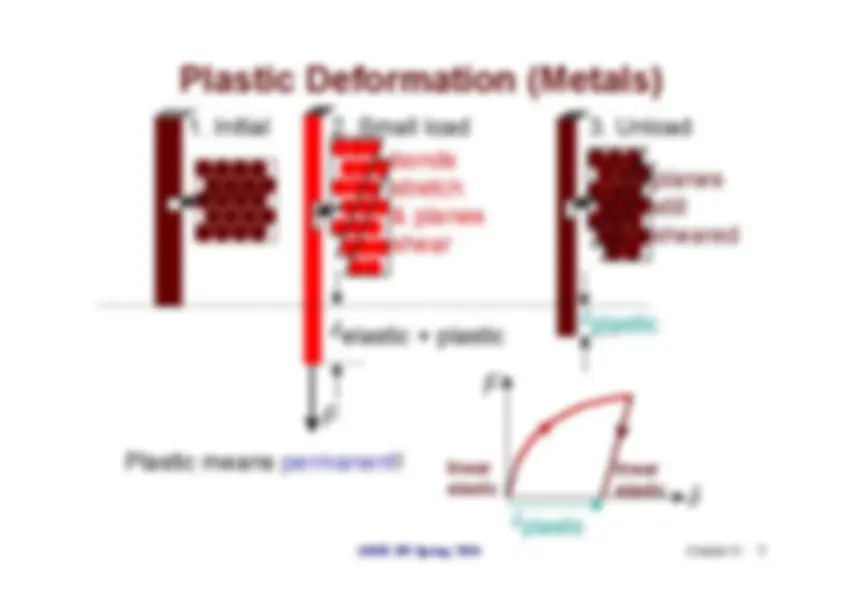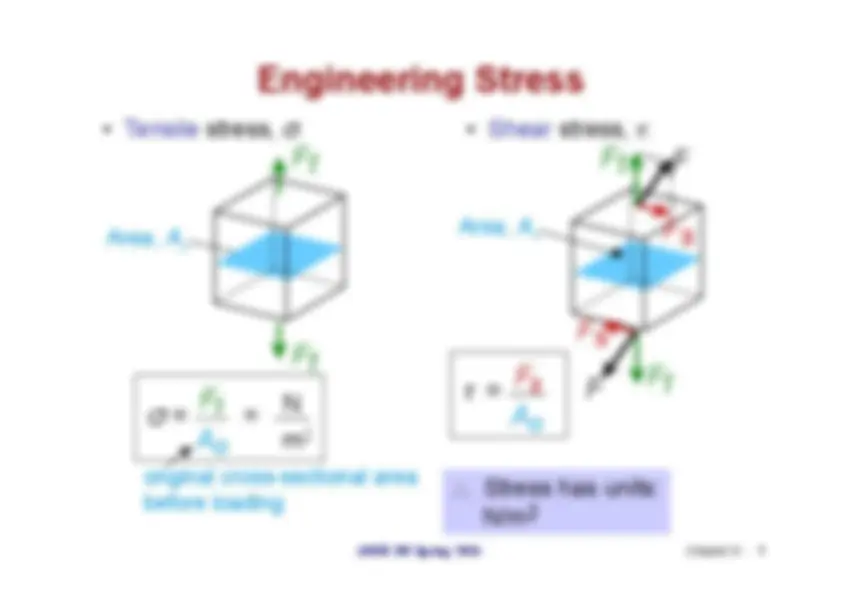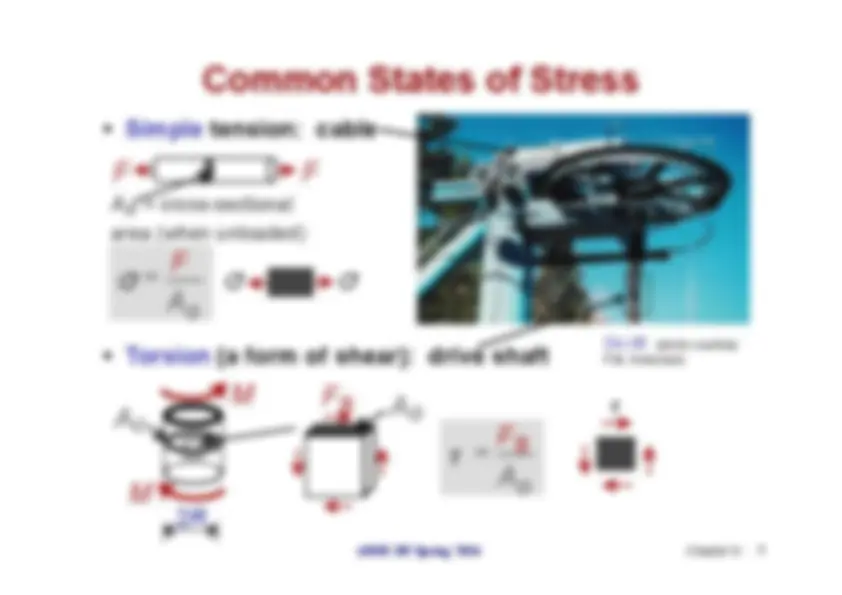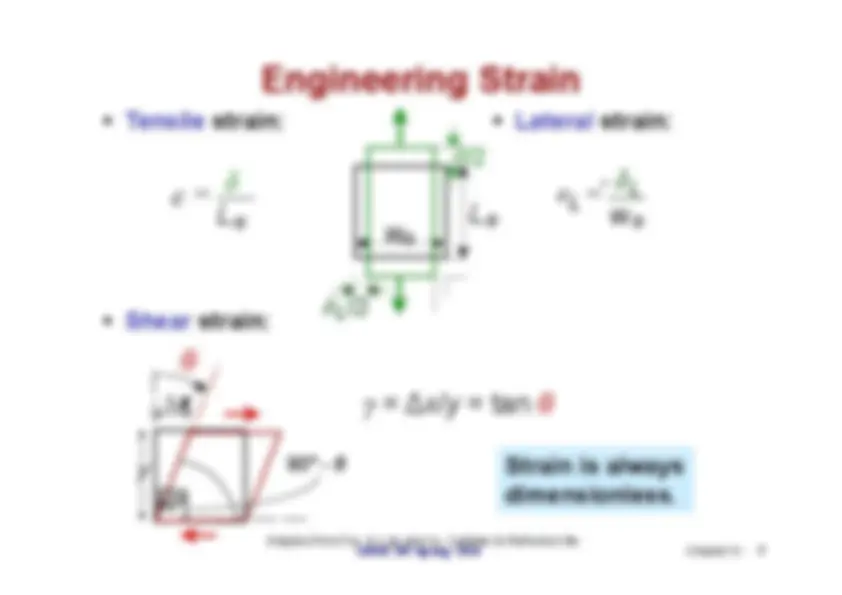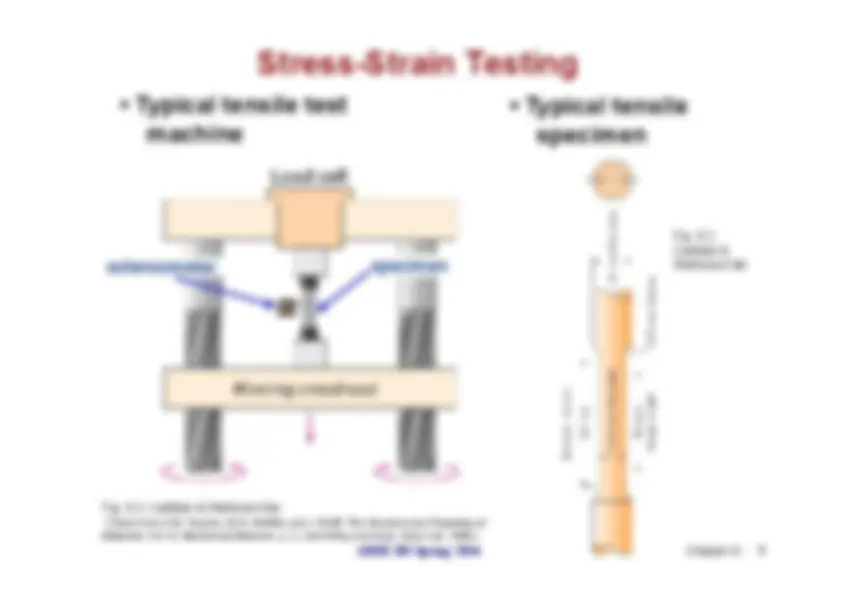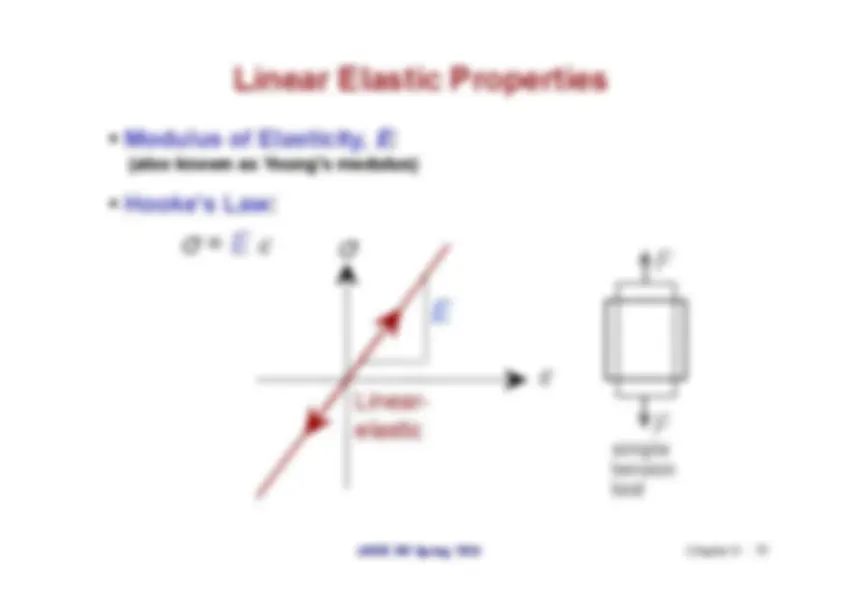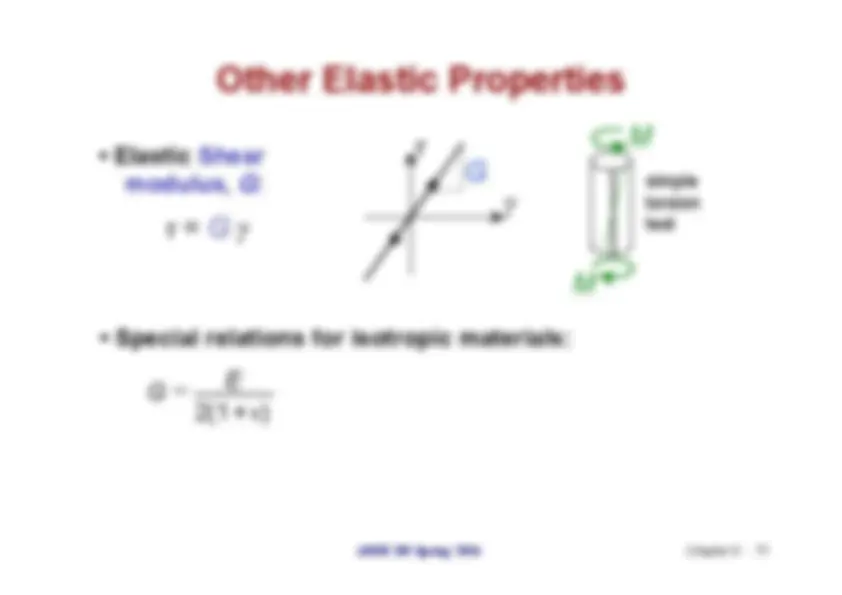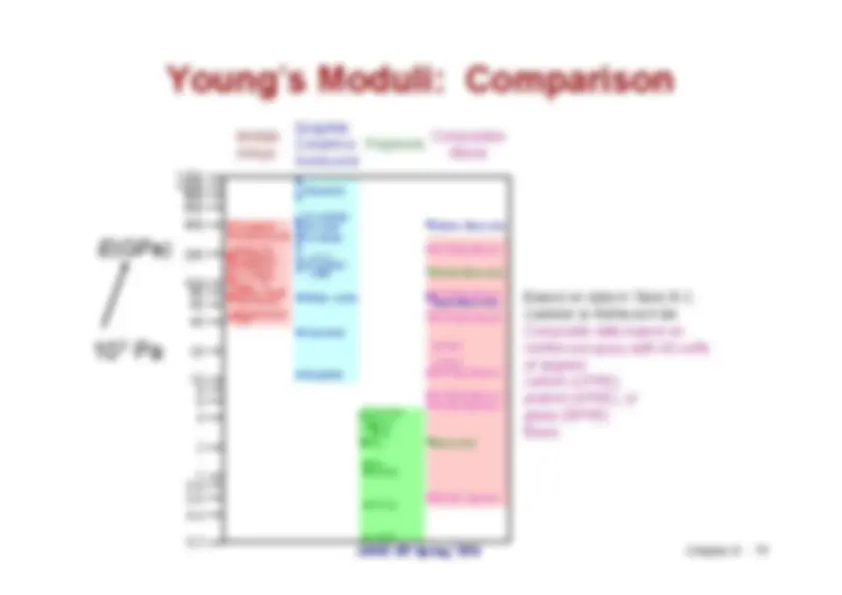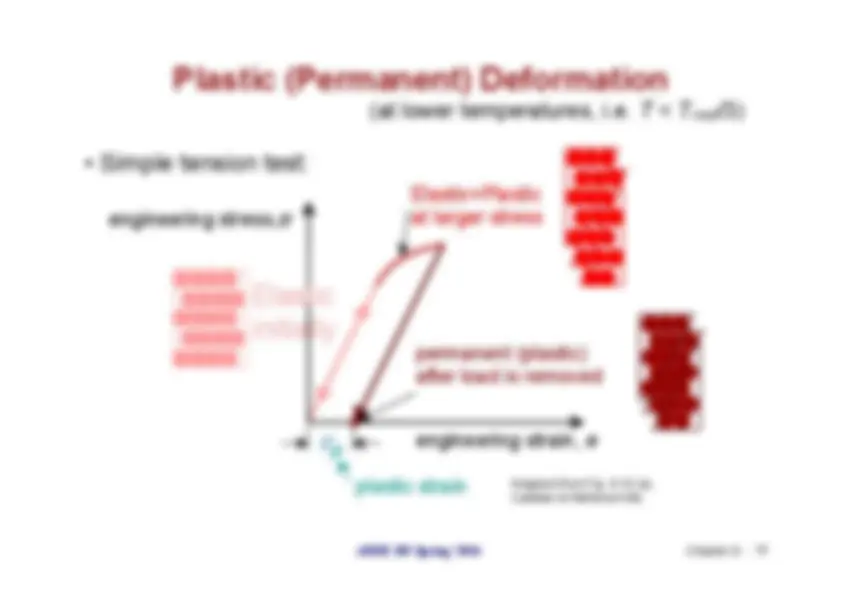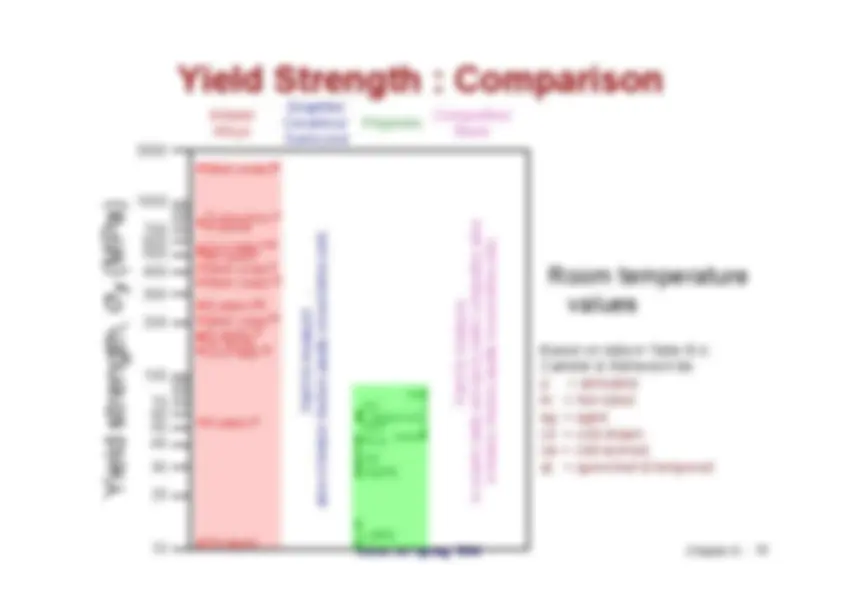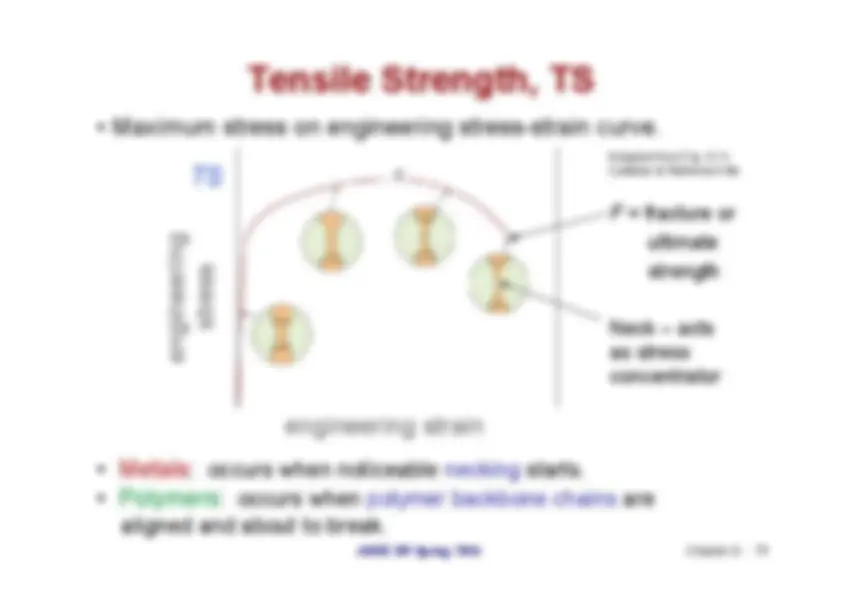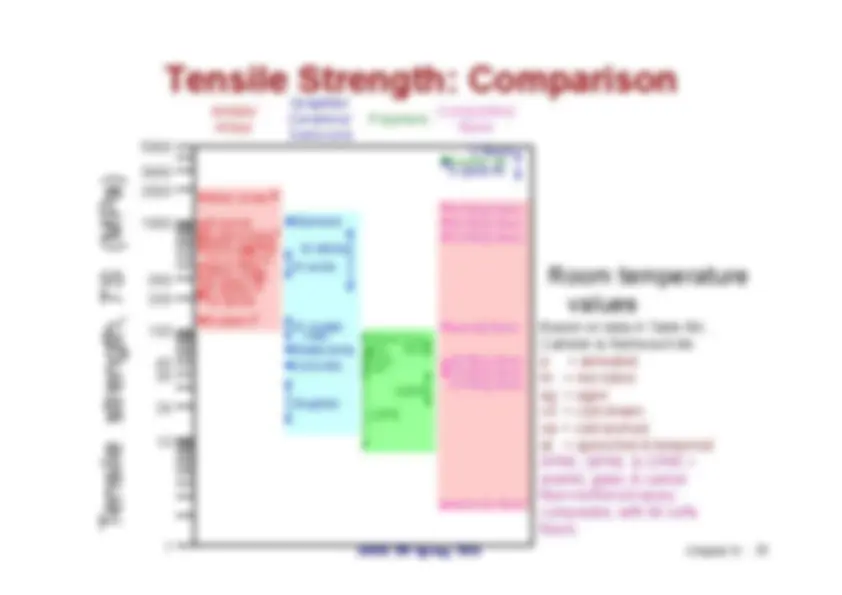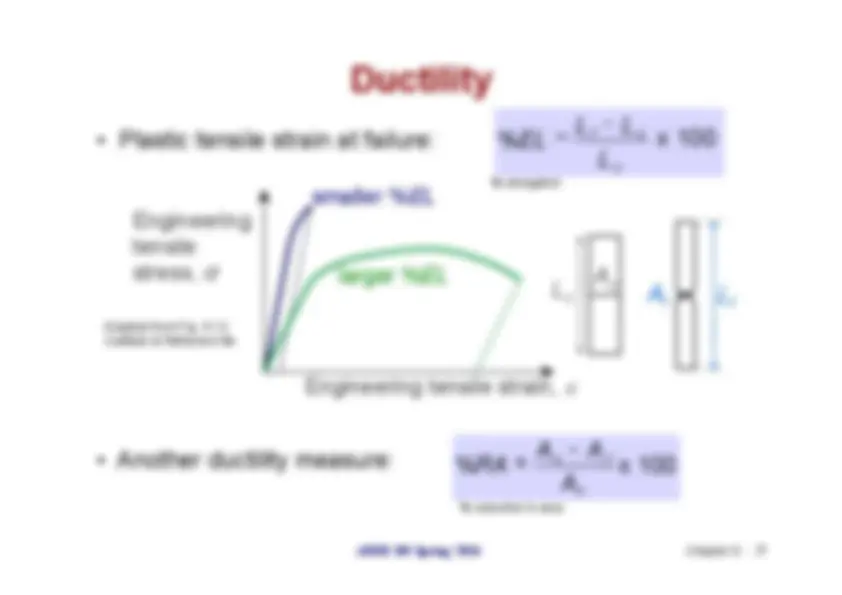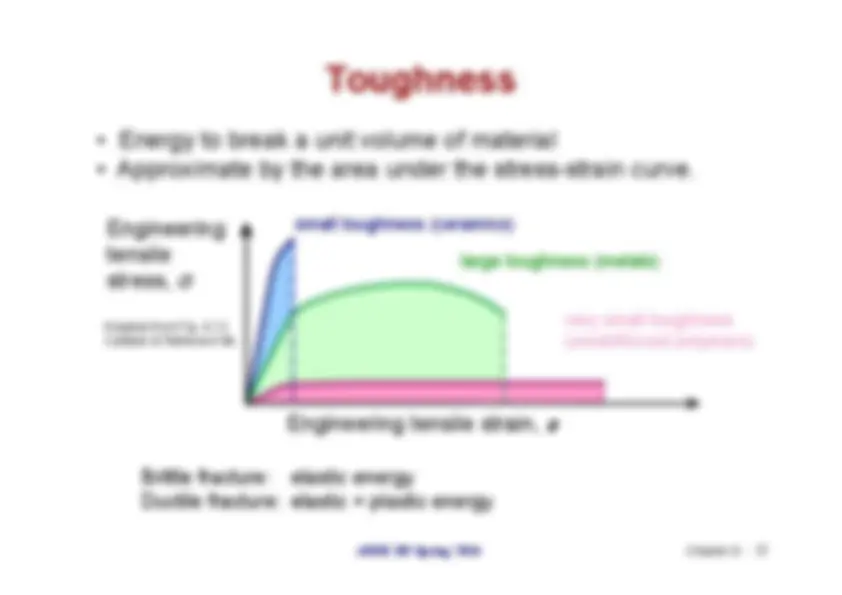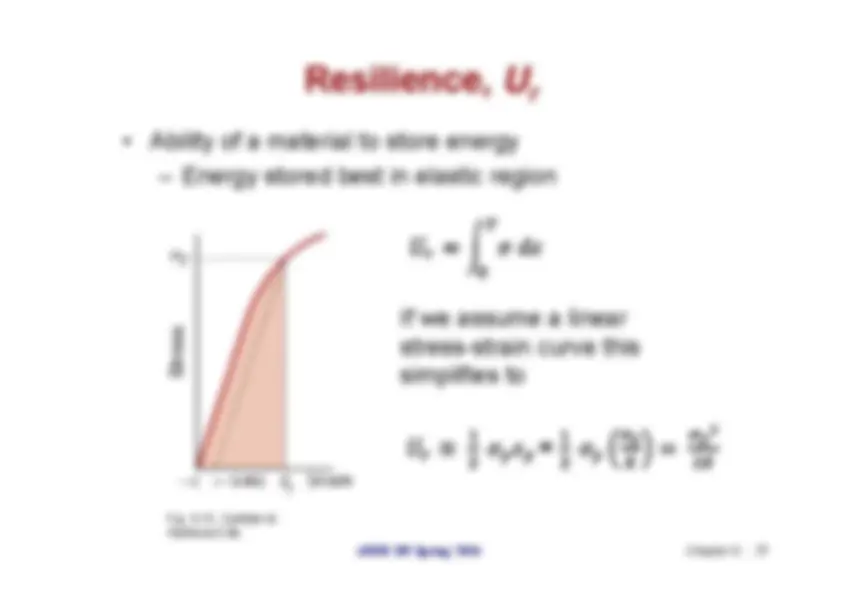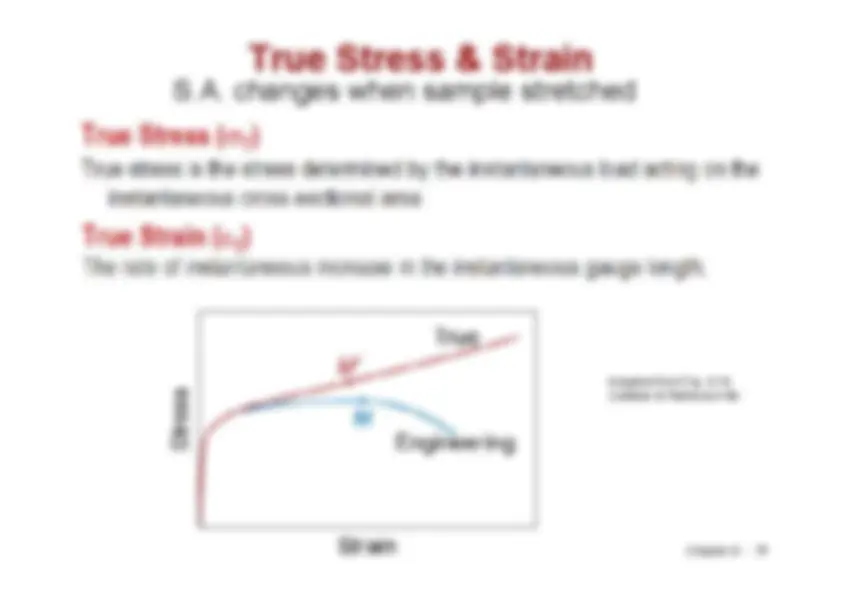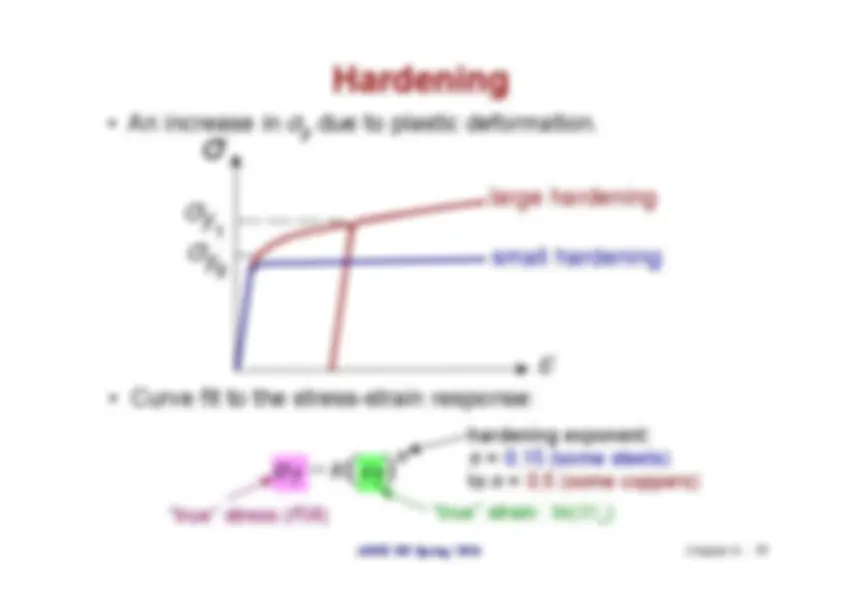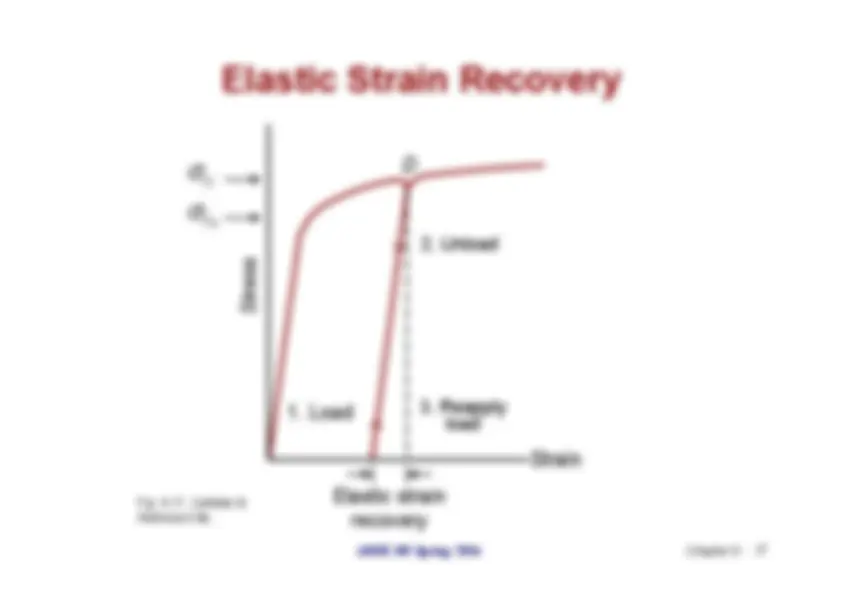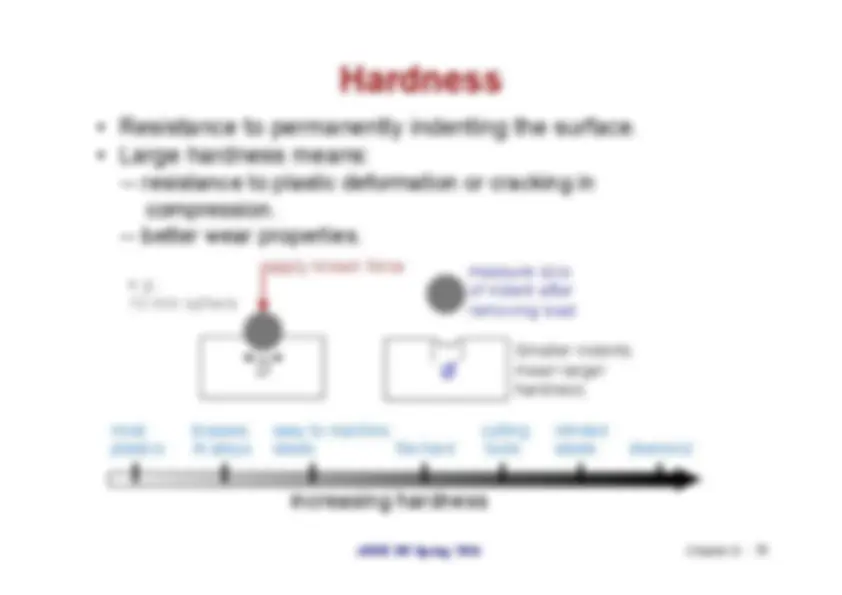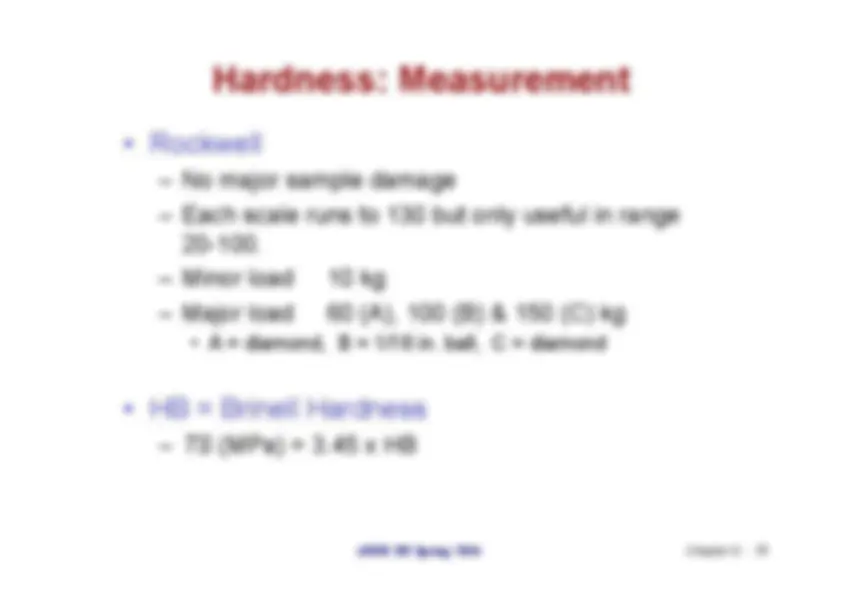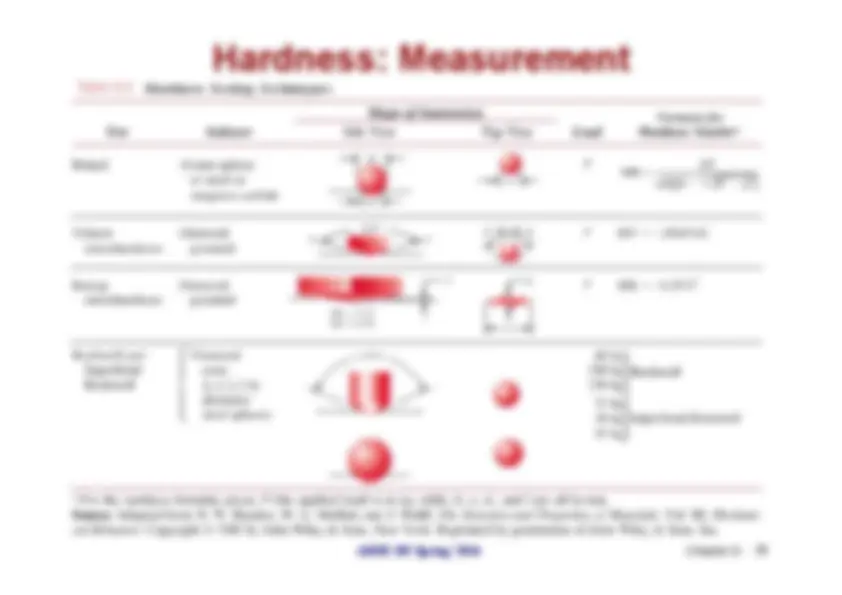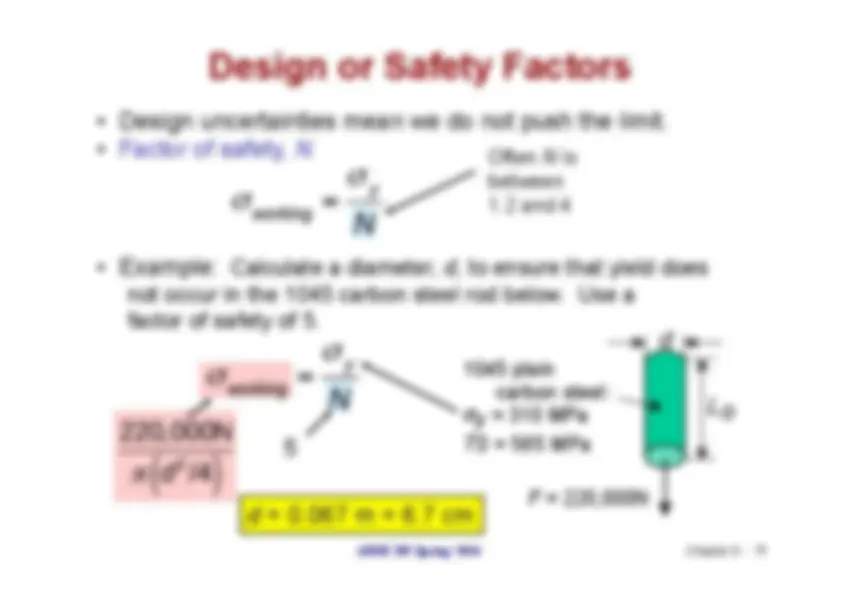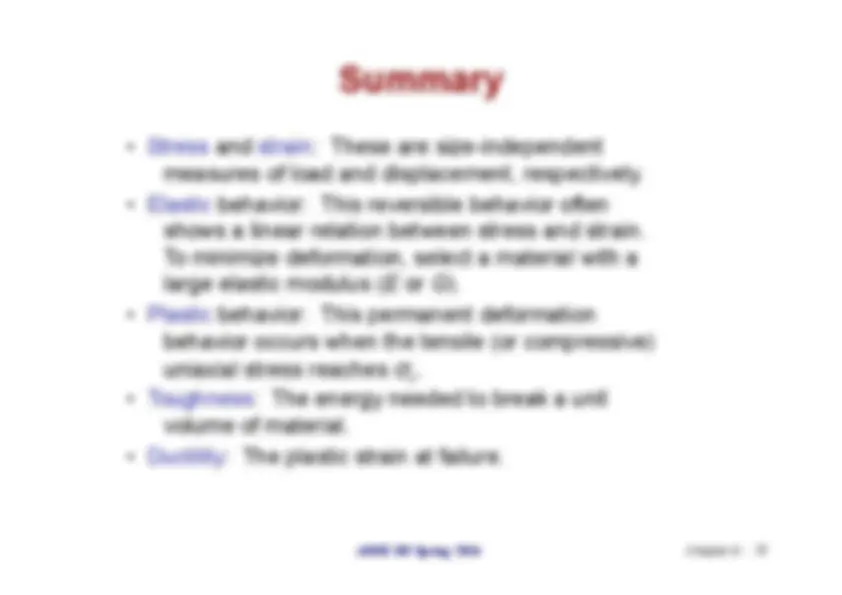Download Mechanical Properties of Metals and more Slides Engineering in PDF only on Docsity!
Chapter 8 - AMSE 205 Spring ‘^
ISSUES TO ADDRESS...• Stress and strain: What are they and why arethey used instead of load and deformation?• Elastic behavior: When loads are small, how muchdeformation occurs? What materials deform least?• Plastic behavior: At what point does permanentdeformation occur? What materials are mostresistant to permanent deformation?• Toughness and ductility: What are they and howdo we measure them?
Chapter 8:
Mechanical Properties of Metals
Chapter 8 - AMSE 205 Spring ‘^
Elastic Deformation Elastic means reversible!
2. Small load^ bondsstretch δ F
1. Initial^
3. Unload return toinitial
F
Linear-elasticNon-Linear-elastic^ δ
Chapter 8 - AMSE 205 Spring ‘^
^ Stress has units:^2 N/m
Engineering Stress
• Shear stress,^
Area,^ A^ o
FtF Fs Fs FtF
Fs τ = A^ o
• Tensile stress,
σ : F N t = σ = 2 m A o original cross-sectional areabefore loading
Area,^ A^ o
Ft Ft
Chapter 8 - AMSE 205 Spring ‘^
• Simple tension: cable
Common States of Stress F = σ A o
Fs = τ Ao
M^ M
A^ o
• Torsion (a form of shear): drive shaft FsA^ c^2 R
Ski lift^ (photo courtesy P.M. Anderson)
Ao = cross-sectional^ area (when unloaded)
F
F
Chapter 8 - AMSE 205 Spring ‘^
**- Bi-axial tension:
- Hydrostatic compression:**
Pressurized tank
σ^ < 0 h (photo courtesyP.M. Anderson)
(photo courtesyP.M. Anderson)
OTHER COMMON STRESS STATES (ii)
Fish under water
σ > 0 θ^ σ > 0 z^
Chapter 8 - AMSE 205 Spring ‘^
• Tensile strain:
• Lateral strain: Strain is alwaysdimensionless.
Engineering Strain• Shear strain: θ x γ^ = Δ x 90º -^ θy 90º
/ y^ = tan^ θ
δ = L^ o^ Adapted from Fig. 8.1 (a) and (c),
δ /2^ -^ L^ owo Callister & Rethwisch 9e.
δL = L w^ o
δ /2 L
Chapter 8 - AMSE 205 Spring ‘^ Linear Elastic Properties• Modulus of Elasticity,^ E : (also known as Young's modulus)• Hooke's Law: σ = E^ ^ σ^ Linear-elastic
E^
F F simpletensiontest
Chapter 8 - AMSE 205 Spring ‘^ Poisson's ratio,
ν
ν : Ratio between radial and axial strainsUnits:^ E : [GPa] or [psi]^ ν : dimensionless
> 0.50 density increases = 0.50 no volume change < 0.50 density decreases(voids form) L^ - ν L ν = - metals: ν ~ 0.33ceramics: ν ~ 0.25polymers: ν ~ 0.
Chapter 8 - AMSE 205 Spring ‘^
• Elastic Shearmodulus,^ G :
τ^ G^ γ
Other Elastic Properties τ = G^ γ
M^ simpletorsiontest M
• Special relations for isotropic materials:^ E = G^^ 2(1 +^ ν )
Chapter 8 - AMSE 205 Spring ‘^
GraphiteMetalsCeramicsPolymers AlloysSemicond
Composites/fibers
E (GPa)
Based on data in Table B.2, Callister & Rethwisch 9e. Composite data based onreinforced epoxy with 60 vol%of alignedcarbon (CFRE),aramid (AFRE), orglass (GFRE)fibers.
Young ’ s Moduli: Comparison Al oxideMolybdenumSi nitrideSteel, NiTantalumSi crystalPlatinumZinc, TiSilver, GoldGlass -sodaAluminumMagnesium,Concrete 9 10 PaGraphite^81 0.6 0.
Carbon fibers onlyAramid fibers onlyGlass fibers onlyGFRECFRE AFRE(^ fibers) *Epoxy onlyPC Wood(^ grain) 12001000 Diamond^800600 Si carbide^400 Tungsten^200 <111><100>Cu alloys^1008060 Tin^402010642 0.8 0.
CFRE(|| fibers)AFRE(|| fibers)GFRE(|| fibers)GFRE(^ fibers)CFRE(^ fibers) *PolyesterPETPS PPHDPEPTFE LDPE
Chapter 8 - AMSE 205 Spring ‘^
• Stress at which
noticeable^ plastic deformation hasoccurred. when
= 0.002 p^
Yield Strength,
σ y = yield strength y Note: for 2 inch sample^ = 0.002 =^
z / z z = 0.004 in
σ tensile stress, σy e engineering strain,^ = 0.002Adapted from Fig. 8.10 (a), p Callister & Rethwisch 9e.
Chapter 8 - AMSE 205 Spring ‘^
Typical stress-strain behavior for a metal
Typical stress-strain behavior for steels
Chapter 8 - AMSE 205 Spring ‘^
Tensile Strength, TS • Metals: occurs when noticeable necking starts.• Polymers: occurs when polymer backbone chains arealigned and about to break.
Adapted from Fig. 8.11, Callister & Rethwisch 9e.
y
Typical response of a metal^ strain
F^ = fracture orultimatestrengthNeck – actsas stressconcentrator
• Maximum stress on engineering stress-strain curve.^ TS stress^ engineeringengineering strain
Chapter 8 - AMSE 205 Spring ‘^
Tensile Strength: Comparison Graphite/Metals/Ceramics/AlloysSemicond^ Si crystal<100>
Composites/Polymersfibers
(MPa)^ TS^ strength, Tensile
Nylon 6,6PVC
qtSteel (4140) W (pure) 1000 aTi (5Al-2.5Sn) aSteel (4140) cwCu (71500) hrCu (71500) Steel (1020)ag 300 Al (6061) Ti (pure) a 200 Ta (pure)aAl (6061) 10010
PETPC PP LDPE
500030002000 DiamondSi nitrideAl oxide Glass-soda^40 Concrete^30 Graphite^20
wood(|| fiber)HDPE wood (^ fiber)
C fibersAramid^ fibE-glass fibAFRE(|| fiber)GFRE(|| fiber)CFRE(|| fiber)Room temperaturevaluesBased on data in Table B4,^ Callister & Rethwisch 9e. GFRE(^ fiber)^ a^ = annealedCFRE(^ fiber)hr^ = hot rolledAFRE(^ fiber)ag = agedcd = cold drawncw = cold workedqt^ = quenched & temperedAFRE, GFRE, & CFRE =aramid, glass, & carbonfiber-reinforced epoxycomposites, with 60 vol%fibers.

